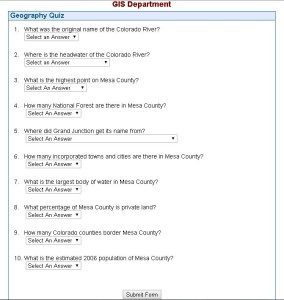The Problem:
The county I work for had a one page geography quiz with outdated questions and a poorly structured user interface. It was just an unstyled list of select dropdowns and a submit button. The answer page that was returned just listed each question with all the answer choices under them. One answer under each question was highlighted in yellow but it wasn’t made clear to the user whether this was the correct answer or just the answer they chose.
 To compound things, the quiz was stuck in an enterprise CMS that gave it a really ugly url. I wanted to change that so it would look good and be really easy to understand. Thankfully I wasn’t restricted to any particular language or technology stack to build the new quiz.
To compound things, the quiz was stuck in an enterprise CMS that gave it a really ugly url. I wanted to change that so it would look good and be really easy to understand. Thankfully I wasn’t restricted to any particular language or technology stack to build the new quiz.
The Solution:
A few years back I had played around with Django and thought it was a cool framework but I had never really applied it to any project. So I said to myself “why not?” and set out to build a new geography quiz app with Django. Over the next couple of days I put together the components of the new application:
- A PostgreSQL database to store the questions and answers
- Models to define the data in the database
- Views to process and send the data and to route user answers to the answer page
- Templates to render the data
Everything seemed to be going along smoothly although I wasn’t very happy with the way I wrote my views to handle the user submitted answers. The app basically builds a form on the fly (questions with radio button answers) then does a POST when the quiz taker clicks the submit button. The view then takes the POST data and turns it into a Python list. The rest of the view just slices and dices the list and uses offsets to pull out the matching questions and answers.
I know there are cleaner ways of doing this. Especially since the returned POST data is a querydict object which is basically just a Python dictionary. Manipulating key/value pairs seems neater. But the way I did it worked and I got it up and running fast. Maybe a project next time I’m bored will be to make the code cleaner and more maintainable.
Another Problem:
Remember earlier when I said that I asked myself “why not?” when considering using Django? Well, I was about to answer that question and the answer wasn’t pretty.
While I was developing my quiz app I used Django’s built-in server which is a lightweight “please don’t use in production” server. It worked great. Then I decided it was time to port the app to my production server and actually use it in the real world. At that point I remembered we use IIS on a Windows server.
IIS isn’t all bad, especially if you work in a place that uses .NET components heavily which I do. Unfortunately, Django was never really developed to run on IIS. Django was really designed to live in a Unix world and be served out with something like Apache. I remembered that from my prior experience with the platform – I just forgot.
Another Solution:
There are several tutorials on the web (most of them several years old) that discuss running Django under IIS but none of them were very straight-forward. The solution that seemed like the quickest route to a running app was to use Helicon’s Python Hosting Package (part of the Helicon Zoo repository available through the IIS Web Package Installer). The hosting package basically loads all of your dependencies and does all of the complicated work of getting IIS to run an antagonistic technology. You then load a Python Project module which builds everything for you including:
- A virtual Python install specific to your app
- A web config file with needed environment variables
- Permissions and application pool settings
The only pain point I had with using Helicon’s solution was discovering it doesn’t work with Django 1.7. I had developed in 1.7 and then when I migrated into the Helicon environment everything broke. This really threw me for a loop for a while until I found a post suggesting using Django 1.6. This didn’t turn out to be a big deal as it didn’t affect my apps functionality. I just had to remove a couple of middleware classes from my settings file and I was good-to-go.
 Conclusion:
Conclusion:
I love working with Django. If I wasn’t in a Windows environment I might be trying to use it throughout my office GIS site. But I can’t see trying to force uncommitted technologies into a relationship they don’t even seem to want. I guess Django is just going to be a hobby framework for me for now. Fortunately there are plenty of others out there just waiting to be learned and implemented.
 Conclusion:
Conclusion:
Great blog. As a .Net developer who likes the simplicity of Python, I get this. I haven’t tried out Django yet for many of the same reasons. Thanks for the pointers.
Thanks Ken! Even with its compatibility issues, Django was a lot of fun to work with.